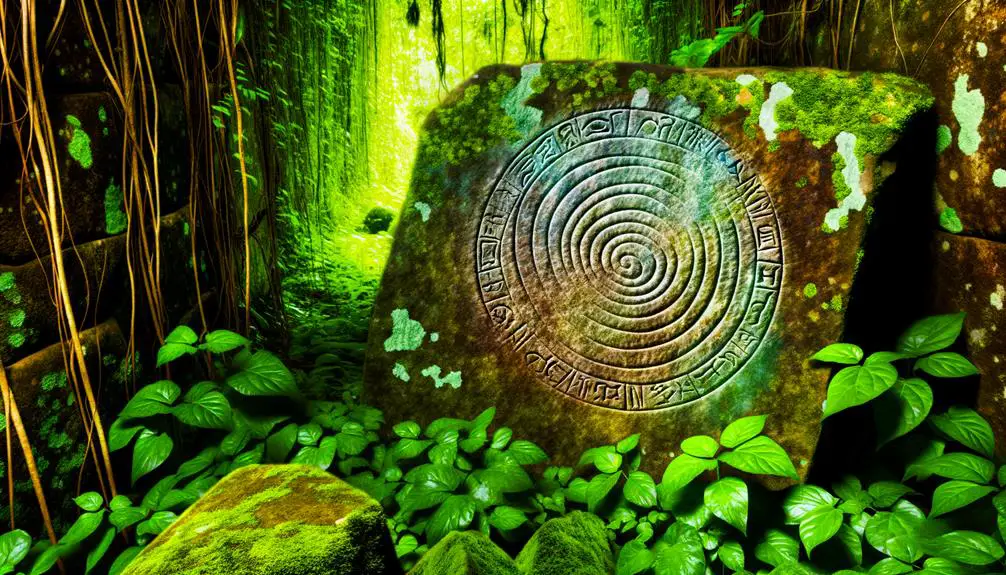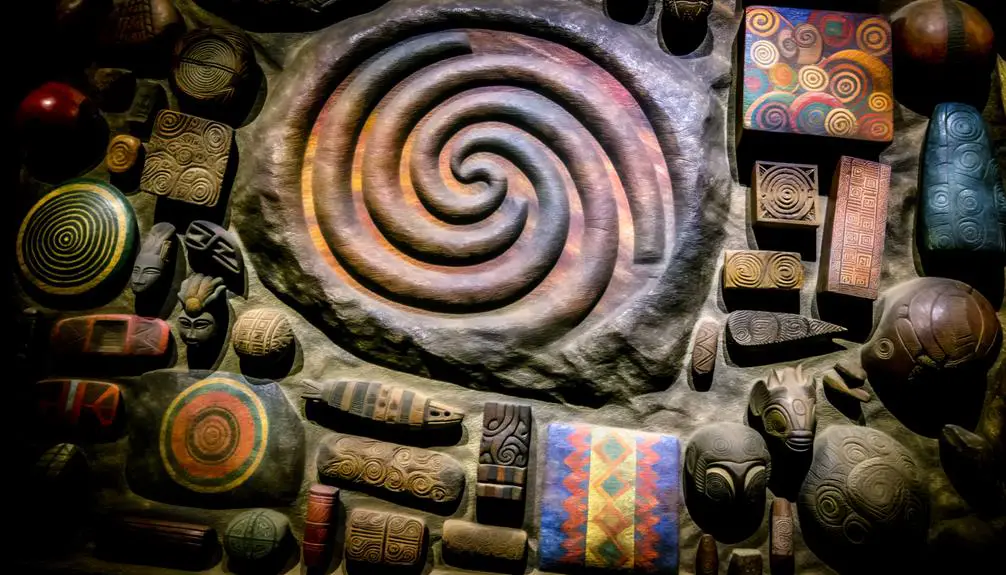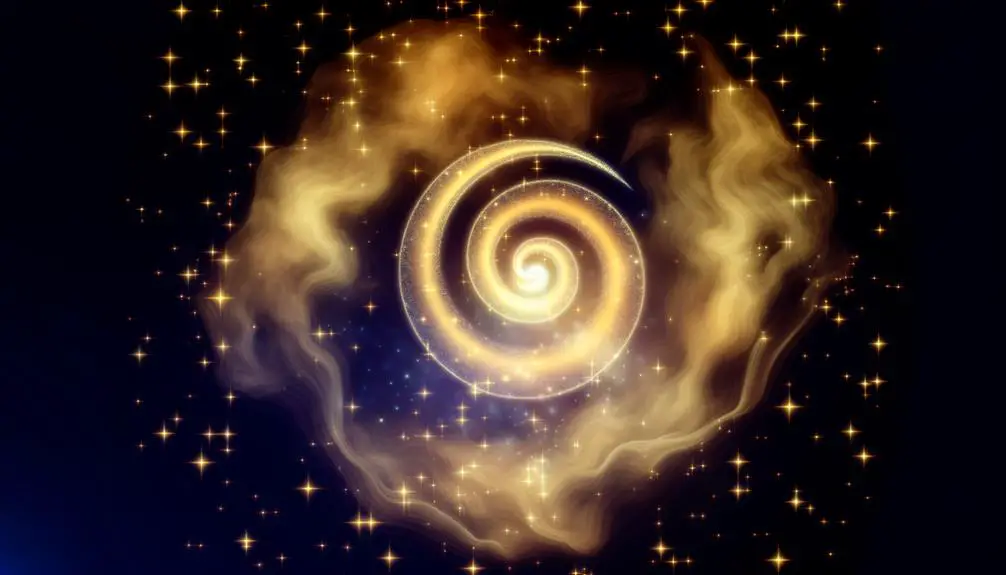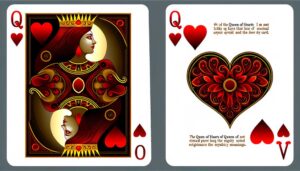What Does the Spiral Symbol’s Meaning Represent Across Cultures?
The spiral symbol, prevalent in ancient artifacts, transcends time and culture. It represents the natural world's phenomena, such as galaxies and whirlpools, and signifies spiritual evolution and enlightenment.
Each turn of the spiral embodies ongoing growth, deeper wisdom, and the cyclical nature of life. In various cultural contexts, it symbolizes fertility, interconnectedness, and the infinite universe.
The spiral's mathematical elegance, seen in the Fibonacci sequence and golden ratio, underscores its universal aesthetic appeal. This symbol's ubiquity in nature and art reveals an intrinsic order, inviting contemplation on life's continuous journey and transformation.
Explore its profound layers further.

Key Takeaways
- The spiral represents continuous growth, evolution, and the journey of self-discovery.
- It symbolizes the cyclical nature of life, transformation, and renewal.
- Spirals are emblematic of spiritual ascent and the quest for higher consciousness.
- Culturally, spirals signify interconnectedness and the infinite nature of the universe.
- Mathematically, spirals showcase the beauty and order of natural patterns through the Fibonacci sequence and golden ratio.
Ancient Origins

Tracing back to prehistoric times, the spiral symbol has been etched into ancient artifacts, revealing its profound significance in early human culture.
Archaeological findings from various regions, including the petroglyphs of Newgrange in Ireland and the rock engravings of the American Southwest, demonstrate the ubiquity and timelessness of this motif.
The spiral's recurring presence in diverse civilizations underscores its integral role in the visual lexicon of our ancestors.
This geometric figure, characterized by its fluid, continuous lines, may have been employed to represent various natural phenomena, such as whirlpools, galaxies, or the cyclical patterns observed in nature.
These interpretations suggest that the spiral served as a versatile symbol, encapsulating early human attempts to comprehend and articulate their environment.
Spiritual Significance
The spiral symbol holds profound spiritual significance, epitomizing the journey of evolution and the continuous cycle of growth. It serves as a metaphor for the path to enlightenment, illustrating how individuals undergo transformation through stages of self-discovery and inner development.
This emblematic shape encapsulates the essence of perpetual progress, guiding adherents toward a deeper understanding of their spiritual ascent.
Symbol of Evolution
As a symbol of evolution, the spiral embodies the continuous journey of growth and transformation in spiritual contexts. This ancient motif signifies the perpetual process of becoming, where each loop represents a phase of development or an ascent in consciousness.
Unlike a linear path, the spiral encapsulates the cyclical nature of progress, suggesting that growth is not merely forward movement but an intricate dance of reflection and renewal. In spiritual traditions, the spiral often denotes the soul's expansion and the unfolding of deeper wisdom.
It serves as a visual metaphor for the evolving self, illustrating that true evolution involves revisiting and reinterpreting past experiences to ascend to higher states of awareness and understanding.
Path to Enlightenment
Embodying the quest for spiritual awakening, the spiral symbol represents the intricate and often arduous path to enlightenment, where each turn signifies deeper layers of insight and transcendence. This symbolic journey underscores the progressive nature of spiritual growth, where each inward curve leads to profound realizations and self-discovery. The spiral's continuous, unending form emphasizes the perpetual quest for higher consciousness and ultimate truth.
Depth of Understanding: Each turn in the spiral is a metaphor for gaining deeper wisdom.
Transcendental Progression: The winding path reflects the ongoing journey towards spiritual ascension.
Infinite Pursuit: The spiral's unbroken line signifies the eternal nature of seeking enlightenment.
This rich symbolism invites introspection, encouraging individuals to embrace the complexities of their spiritual journey.
Cycle of Growth
Integral to spiritual development, the cycle of growth represented by the spiral symbol underscores the perpetual phases of transformation and renewal inherent in the journey toward enlightenment.
This emblematic form, found in numerous spiritual traditions, illustrates the dynamic process of evolving consciousness. Each loop signifies a stage of personal growth, where the inward journey leads to profound self-awareness, while the outward expansion reflects the integration of newfound wisdom into daily life.
The spiral's endless progression embodies the concept that spiritual maturity is not a linear ascent but a continuous, iterative process. It invites individuals to embrace each phase of their spiritual evolution, recognizing that growth is cyclical, with each turn of the spiral bringing deeper understanding and higher levels of spiritual insight.
Cultural Interpretations

Across various cultures, the spiral symbol has been imbued with profound meanings that reflect the complexities of human spirituality, nature, and cosmic understanding. This ancient motif, prevalent in art and artifacts, serves as a confirmation to its universal significance.
- Celtic Tradition: The spiral represents growth, fertility, and the cyclical nature of life and death, often found in stone carvings and jewelry.
- Indigenous Cultures: In Native American symbolism, the spiral signifies the journey of life and the interconnectedness of all things.
- Eastern Philosophy: The spiral is emblematic of the universe's infinite nature and the path to enlightenment, frequently seen in mandalas and temple designs.
These interpretations underscore the spiral's role as a bridge between the tangible and the metaphysical.
Mathematical Beauty
The spiral's mathematical elegance, exemplified by the Fibonacci sequence and the golden ratio, reveals an intrinsic harmony that resonates through nature, art, and architecture.
This alignment of numerical patterns manifests in the logarithmic spiral, where each turn is a constant factor larger than the previous one. Such precision underscores the universal applicability of mathematical principles, highlighting a profound interconnectedness.
The golden ratio, approximately 1.618, is particularly esteemed for its aesthetically pleasing proportions, frequently employed in artistic compositions and architectural designs. This ratio's recurrence in spiral forms underscores its role in creating balanced and visually appealing structures.
Consequently, the spiral symbolizes not merely a mathematical concept but an emblem of beauty and order that transcends cultural and temporal boundaries.
Nature's Spirals

Frequently manifesting in various forms, spirals in nature illustrate the profound connection between biological growth patterns and mathematical principles. These spirals, governed by the Fibonacci sequence and the Golden Ratio, reveal an intrinsic order in nature's seemingly chaotic designs. Observing these patterns provides insight into the harmonious interplay between form and function.
Key examples include:
- Nautilus Shells: Demonstrating logarithmic spirals, these shells grow proportionally, maintaining their shape as they expand.
- Galaxies: Spiral galaxies, such as the Milky Way, exhibit grand, sweeping arms, embodying cosmic order and gravitational dynamics.
- Sunflowers: The arrangement of seeds in the flower head follows a spiral pattern, optimizing space and resource distribution.
These natural spirals underscore the universality and elegance of mathematical patterns in the organic world.
Modern Uses
In contemporary society, the spiral symbol has transcended its ancient origins, becoming a prominent feature in both artistic expressions and practical applications.
Its presence is significantly significant in art and fashion trends, where it serves as a motif of dynamic elegance and infinite possibilities.
Additionally, it plays a pivotal role in meditation and mindfulness tools, symbolizing the journey inward towards personal growth and enlightenment.
Art and Fashion Trends
Modern art and fashion have embraced the spiral symbol as a versatile motif that conveys both aesthetic appeal and profound symbolic meaning. Its recurring presence in various contemporary contexts speaks to its enduring relevance. The spiral's fluid and dynamic form allows it to seamlessly integrate into diverse creative expressions.
Fashion Design: Spirals are frequently featured in patterns, accessories, and haute couture, symbolizing growth and evolution.
Visual Arts: Artists employ spirals to evoke movement, natural forms, and the cosmic order, enriching their works with deeper layers of interpretation.
Interior Design: Spiral motifs in architecture and decor elements create focal points that draw the eye and symbolize continuity and harmony.
This symbol's adaptability underscores its significant role in modern aesthetic and conceptual frameworks.
Meditation and Mindfulness Tools
The spiral symbol finds a profound application in meditation and mindfulness tools, where it serves as a visual aid to guide focus and facilitate deeper states of awareness. This ancient emblem resonates with the cyclical nature of existence and personal growth. In modern mindfulness practices, it is often employed to help individuals center their thoughts and reach a meditative state more effectively. The spiral's continuous loop can symbolize the journey inward, promoting introspection and spiritual awakening.
| Aspect | Significance |
|---|---|
| Visual Focus | Enhances concentration |
| Symbolic Resonance | Represents personal and spiritual growth |
| Cyclical Imagery | Reflects life's ongoing patterns |
| Meditation Aid | Facilitates deeper states of awareness |
| Mindfulness Anchor | Helps maintain presence in the moment |
Personal Symbolism

Often imbued with deep personal meaning, the spiral symbol serves as a powerful representation of individual journeys, growth, and transformation. This ancient motif transcends mere ornamentation, offering a profound narrative of human experience.
Its ever-widening loops can signify life's continual evolution, embodying a personal odyssey marked by introspection and enlightenment.
- Journey of Self-Discovery: The spiral invites contemplation on one's path, highlighting the importance of both progress and retrospection.
- Symbol of Resilience: Its unending nature epitomizes endurance and the perpetual quest for improvement.
- Evolution of Thought: The spiral captures the fluidity of intellectual and emotional development, underscoring the non-linear nature of personal growth.
Conclusion
The spiral symbol, with its ancient origins and profound spiritual significance, continues to captivate diverse cultures and disciplines. Its presence in nature and mathematics underscores its universal appeal and inherent beauty.
Modern uses and personal interpretations further attest to its enduring relevance. What deeper truths might be uncovered through continued exploration of this ubiquitous motif?
The spiral, in its many forms, remains a potent symbol of life's cyclical and ever-evolving journey.






